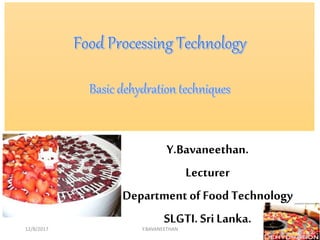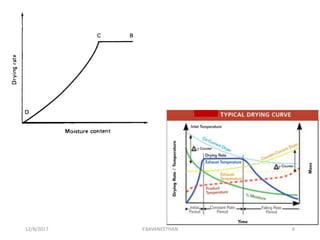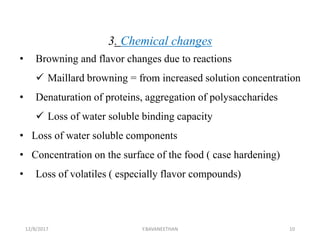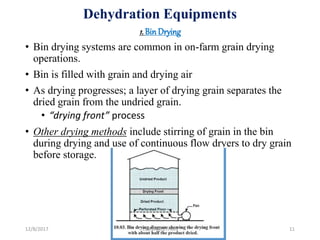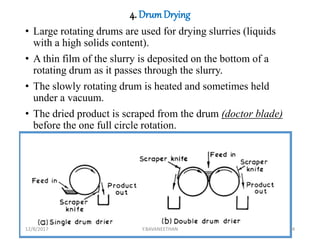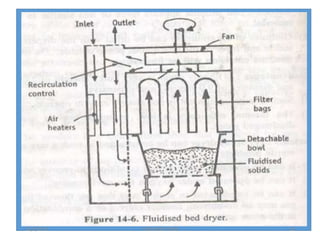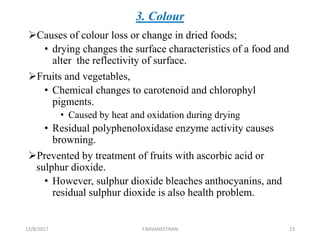- 1. 1
Y.Bavaneethan.
Lecturer
Department of Food Technology
SLGTI. SriLanka.
12/8/2017 Y.BAVANEETHAN
- 2. Dehydration
Dehydration (or drying) is defined as ‘the application of
heat under controlled conditions to remove the majority of
the water normally present in a food by evaporation.
The main purpose of dehydration is to extend the shelf life
of foods by a reduction in water activity.
This is inhibits microbial growth and enzyme activity, but;
• The processing temperature is usually insufficient to cause
their inactivation.
• Therefore any increase in moisture content during storage,
result in rapid spoilage.
Drying causes deterioration of both the eating quality and
the nutritional value of the food.
• The design and operation of dehydration equipment aim to
minimize these changes.
12/8/2017 Y.BAVANEETHAN 2
- 3. Preservation effect
• Dehyrated foods have lower water activity (aw=0.2-0.6)
• This aw not enough (free water) for :
• Microorganism Growth (needs aw > 0.93, Specially
bacteria)
• Staphylococcus aureus (aw > 0.85)
• Mold ( need aw >0.6)
• Enzymatic reactions
• Chemical reactions (eg) Mailllard browning) (need
aw>0.3)
• Microorganisms are not killed,
• Keep Mos in-active stage.
• MO will resume growth after food is rehydrated (suitable
environment)12/8/2017 Y.BAVANEETHAN 3
- 4. Controlling Factors for Dehydration
• Two separate phenomena are involved in
dehydration.
First, moisture must move from the interior to surface of
the material. This is occur two ways:
capillary action or diffusion.
Movement by capillary action occur during early
stages of drying.
• Second, the surface water must be evaporated into
air.
• Evaporation rate depend on;
• condition of drying air, and
• concentration of water at the surface.
12/8/2017 Y.BAVANEETHAN 4
- 5. Factors affecting dehydration
• Surface area
• Smaller food piece, more rapid the rate of moisture loss
• Temperature
• Increase in temperature will increase the dehydration rate
• Air velocity
• Maximize velocity of heated air moving around the food particles
• Humidity of drying air
• The drier the air, the moisture it can absorb
• % RH (relative humidity) of the drying air determines the final
moisture content of food
• Atmospheric pressure and vacuum
• Water boils at 100oC ( at a pressure of 1 atm= 760Hg)
• At lower pressure the boiling temperature will decrease
• Eg. Under vacuum, water will boil at 32oC
• Important for heat sensitive food products
• MOSTLY USED FOR FREEZE DRYING
12/8/2017 Y.BAVANEETHAN 5
- 6. 12/8/2017 Y.BAVANEETHAN 6
- 7. Aw for some dried foods
Product aW
Skim milk powder
Dehydrated soups
0.03
noodles 0.5
Fruit: berries, apples, apricots, raisins ( grapes) 0.6
Fruit juice concentrates, condensed milk 0.8
12/8/2017 Y.BAVANEETHAN 7
- 8. Changes during dehydration
1. Cell/ tissue shrinkage
2. Case hardening
3. Chemical changes
1. Shrinkage
• Shrinkage water migrates- interior of the food surface
• Evaporates by the drying medium
• Water carries with it water soluble substances dissolved in it
12/8/2017 Y.BAVANEETHAN 8
- 9. 2. Case hardening
• Rapid drying- compounds (such as sugar) form a
hard, impermeable “case” around the food piece.
• Can slow down the dehydration
• Common in high sugar products
• Tropical and temperate fruit products
12/8/2017 Y.BAVANEETHAN 9
- 10. 3. Chemical changes
• Browning and flavor changes due to reactions
Maillard browning = from increased solution concentration
• Denaturation of proteins, aggregation of polysaccharides
Loss of water soluble binding capacity
• Loss of water soluble components
• Concentration on the surface of the food ( case hardening)
• Loss of volatiles ( especially flavor compounds)
12/8/2017 Y.BAVANEETHAN 10
- 11. Dehydration Equipments
1. Bin Drying
• Bin drying systems are common in on-farm grain drying
operations.
• Bin is filled with grain and drying air
• As drying progresses; a layer of drying grain separates the
dried grain from the undried grain.
• “drying front” process
• Other drying methods include stirring of grain in the bin
during drying and use of continuous flow dryers to dry grain
before storage.
12/8/2017 Y.BAVANEETHAN 11
- 12. 2. Cabinet Drying
• Cabinet dryers are usually small, insulated units with;
• A heater, circulating fan, and shelves to hold the product to
be dried.
• General procedure is to force heated air over multiple trays.
• However, greater energy efficiencies can be obtained if some
of the heated air is recirculated.
• Basic operation of a cabinet dryer with recirculation.
• Energy savings of 50% or more can be achieved with
recirculation.
12/8/2017 Y.BAVANEETHAN 12
- 13. 3. Tunnel Drying
• Tunnel dryers are a large-scale modification of the cabinet
dryer concept.
• The drying chamber is a tunnel with multiple carts
containing trays.
• New carts of undried product are loaded at one end of the
tunnel.
• product are removed from the other end.
• Air flow in these dryers may be Parallel or Counter to the
movement of carts in the tunnel.
Tunnel dryer sketches showing (a) parallel and (b) counter flow operation
12/8/2017 Y.BAVANEETHAN 13
- 14. 4. DrumDrying
• Large rotating drums are used for drying slurries (liquids
with a high solids content).
• A thin film of the slurry is deposited on the bottom of a
rotating drum as it passes through the slurry.
• The slowly rotating drum is heated and sometimes held
under a vacuum.
• The dried product is scraped from the drum (doctor blade)
before the one full circle rotation.
12/8/2017 Y.BAVANEETHAN 14
- 15. 5. Fluidised-beddriers
• The main features of a fluidised-bed drier;
evenly distribute the air at a uniform velocity around the bed
of material.
• Produce an homogenous region of air and prevent localised high
velocities,
disengagement or ‘freeboard’ region above the bed to allow
disentrainment of particles.
• Hot air is blown through the bed, causing;
the food to become suspended ( Problem)
To overcome this;
vigorously agitated (fluidised), exposing the maximum
surface area of food for drying.
12/8/2017 Y.BAVANEETHAN 15
- 16. 12/8/2017 Y.BAVANEETHAN 16
- 17. 6. SprayDrying
• Spray drying is used to dry liquid products. The product to be
dried is sprayed into a stream of heated air.
• The two major operations of concern in spray drying are;
• Droplet atomization and
• Powder collection.
• To optimize drying, droplets should be small and uniform in
size.
• Special procedures must be used to insure that atomization
is satisfactory.
• Collection of the dried powder also requires special
techniques.
• The powder particles are small and move easily within an
air stream.
12/8/2017 Y.BAVANEETHAN 17
- 18. SPRAY DRYER
12/8/2017 Y.BAVANEETHAN 18
- 19. 7. Freeze Drying
• Freeze drying involves the removal of moisture from a frozen
product .
• The temperature must be below freezing for that product (insure
that product remains frozen)
• And the vapor pressure must be maintained at a very low
level to permit moisture removal by sublimation.
• Because of the low temperature, low pressure, and low
drying rate, freeze drying is quite expensive compared
other drying methods.
• However, freeze drying produce high quality dried
products.
• “Freezer burn,” sometimes seen in frozen foods,
• undesirable of freeze drying. (very slow type freeze).
12/8/2017 Y.BAVANEETHAN 19
- 20. 12/8/2017 Y.BAVANEETHAN 20
- 21. Effect on Foods
Products undergo changes during drying that reduce their
quality compared to the fresh material.
1. Texture
Rupture, crack, compress and permanently distort the relatively
rigid cells,
• Change texture apperance
• To give the food a shrunken shriveled appearance.
Re-hydrated product absorbs water more slowly and does not
regain the firm texture of the fresh material.
Drying pieces of meat - severe changes in texture.
• Caused by aggregation and denaturation of proteins and loss
of water-holding capacity.
Case hardening effect.
• reduces the rate of drying to produce a food with a dry
surface and a moist interior.12/8/2017 Y.BAVANEETHAN 21
- 22. 2. Flavor and Aroma
Heat not only vaporises water during drying but also causes
loss of volatile components.
Volatile loss depends on;
• Temperature and moisture content of the food
• And the vapour pressure of the volatiles and their solubility in
water.
The open porous structure of dried food allows access of
oxygen,
• which is a second important cause of aroma loss due to
oxidation of volatile components and lipids during storage.
These changes are can reduced by:
• vacuum or gas packing
• low storage temperatures
• maintenance of low moisture contents
• addition of synthetic antioxidants
• preservation of natural anti-oxidants.12/8/2017 Y.BAVANEETHAN 22
- 23. 3. Colour
Causes of colour loss or change in dried foods;
• drying changes the surface characteristics of a food and
alter the reflectivity of surface.
Fruits and vegetables,
• Chemical changes to carotenoid and chlorophyl
pigments.
• Caused by heat and oxidation during drying
• Residual polyphenoloxidase enzyme activity causes
browning.
Prevented by treatment of fruits with ascorbic acid or
sulphur dioxide.
• However, sulphur dioxide bleaches anthocyanins, and
residual sulphur dioxide is also health problem.
12/8/2017 Y.BAVANEETHAN 23
- 24. Calculation
12/8/2017 Y.BAVANEETHAN 24
- 25. 12/8/2017 Y.BAVANEETHAN 25

